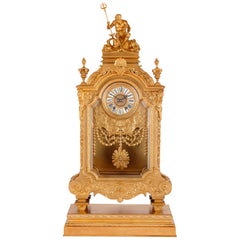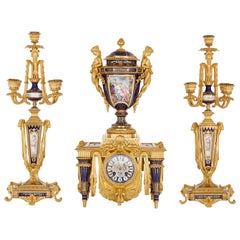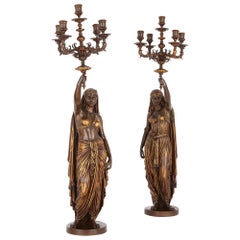Want more images or videos?
Request additional images or videos from the seller
1 of 11
Gilt and Patinated Bronze Ewer on Stand, Attributed to Barbedienne
Price:$9,000
$13,088.35List Price
About the Item
- Attributed to:Ferdinand Barbedienne (Metalworker)
- Dimensions:Height: 43.31 in (110 cm)Width: 17.72 in (45 cm)Depth: 17.72 in (45 cm)
- Style:Neoclassical (In the Style Of)
- Materials and Techniques:
- Place of Origin:
- Period:
- Date of Manufacture:Late 19th Century
- Condition:Wear consistent with age and use.
- Seller Location:London, GB
- Reference Number:Seller: 151341stDibs: LU95639781211
About the Seller
5.0
Recognized Seller
These prestigious sellers are industry leaders and represent the highest echelon for item quality and design.
Gold Seller
Premium sellers maintaining a 4.3+ rating and 24-hour response times
Established in 1975
1stDibs seller since 2012
415 sales on 1stDibs
Typical response time: 4 hours
Associations
The British Antique Dealers' AssociationInternational Confederation of Art and Antique Dealers' Associations
Authenticity Guarantee
In the unlikely event there’s an issue with an item’s authenticity, contact us within 1 year for a full refund. DetailsMoney-Back Guarantee
If your item is not as described, is damaged in transit, or does not arrive, contact us within 7 days for a full refund. Details24-Hour Cancellation
You have a 24-hour grace period in which to reconsider your purchase, with no questions asked.Vetted Professional Sellers
Our world-class sellers must adhere to strict standards for service and quality, maintaining the integrity of our listings.Price-Match Guarantee
If you find that a seller listed the same item for a lower price elsewhere, we’ll match it.Trusted Global Delivery
Our best-in-class carrier network provides specialized shipping options worldwide, including custom delivery.You May Also Like
19th Century French Gilt Bronze Urn Form Compote Attributed to Barbedienne
By Ferdinand Barbedienne
Located in Pittsburgh, PA
This finely detailed gilt bronze compote features a border of vintage motif including grapes and grape leaves. The compote is mounted on a verde antique marble base.
Category
Antique Mid-19th Century French Napoleon III Planters, Cachepots and Jar...
Materials
Bronze
$1,500
H 7 in W 10 in D 7 in
Fine Pair of Parcel-Gilt and Patinated Bronze Neo-Grec Bronze Barbedienne Vases
By Ferdinand Barbedienne
Located in New York, NY
Fine pair of parcel-gilt and patinated bronze neo-grec bronze vases and rouge griotte marble. Designed by Ferdinand Levillain, cast by Ferdinand Barbedienne. Signed 'F. LEVILLAIN' , ...
Category
Antique 19th Century French Vases
Materials
Bronze
$18,000 / set
H 25 in Dm 6 in
19th Century Silvered Bronze Athénienne Jardinière by Ferdinand Barbedienne
By Ferdinand Barbedienne
Located in Oxfordshire, United Kingdom
A French silvered-bronze athénienne by Ferdinand Barbedienne, Paris, last quarter 19th century with a revolving liner, the frieze applied with bucrania suspending ribbon-tied berried laurel swags above a border of bellflowers on a stippled ground above three seated female sphinxes issuing stylised foliage and scrolls on lion monopodia cast with the mask of Hercules, scrolling foliage and anthemions joined by stretchers, raised on a concave-sided triform marble base on a further thin silvered-bronze base, inscribed to the tripod base 'F. BARBEDIENNE'
Measures: 103.3cm. high, 41.5cm. diameter; 3ft. 4 3/8 in, 1ft. 4 1/4.
This impressive athénienne is a key reminder of the longevity of a particular model and design’s success from Antiquity through to the 19th century and up until this day. Typically known as the ‘Trépied du Temple d’Isis’, this athénienne is designed after the Roman antique originally found at Pompeii and now at the Museo Archeologico Nazionale, Naples (fig.1). From being for example an inspiration for the baptismal font of Napoléon’s son in 1811, this model was the inspiration to many highly skilled makers throughout the 19thcentury such as the Manfredini brothers from Milan and of course the Parisian well-established bronze founder Ferdinand Barbedienne who executed the present example.
The Temple of Isis was a Roman temple dedicated to the Egyptian goddess Isis and was among one of the first discoveries during the excavation of Pompeii in 1764. Certainly considered as one of the most elegant examples of antique tripods, the existence of this model was then popularized to the rest of Europe via prints, one of the first being by Giovanni Battista Piranesi in 1779. This type of tripod was also popularised by an engraving in C. Percier and P. Fontaine’s, Receuil de Décorations Intérieures of 1801. Interestingly, there is also a watercolour now in the Musée Carnavalet, Paris, showing this type of tripod displayed at the 1801 Exposition des Produits de L’Industrie in the Louvre.
The passion for Greek and Roman Art in the 19th century.
The discovery of Pompeii and Herculaneum around the middle of the 18th century gave rise to a new passion for Antiquity and the excavated masterpieces renewed the repertoire of fine and decorative arts and served as models for Neoclassicism. Members of the aristocracy as well as connoisseurs, particularly in England, completed their education by undertaking a ‘Grand Tour’ of Italy and often fell victim to the recently unearthed Greek and Roman artefacts...
Category
Antique 19th Century French Grand Tour Planters, Cachepots and Jardinières
Materials
Marble, Silver Plate, Bronze
$68,197
Free Shipping
H 40.56 in Dm 16.34 in
Pair of Directoire Gilt and Patinated Bronze Ewers
Located in Kittery Point, ME
In the neoclassical taste, the open reeded spouts above ovoid bodies with leaf-clasped socles on square bases, the handles terminating in a female mask.
This pair of ewers...
Category
Antique 1790s French Directoire Vases
Materials
Bronze
Pair of Bronze and Gilt Classical Vases by Barbedienne, 19th Century
By Ferdinand Barbedienne
Located in London, by appointment only
A fine pair of 19th-century Bronze and Gilt Classical Vases By Ferdinand Barbedienne 1810-1892.
Each is unique with male nude figures in classical Greek poses playing music and ad...
Category
Antique 19th Century French Neoclassical Vases
Materials
Bronze
$22,043 / set
H 13.59 in Dm 5.52 in
Bronze and Gilt-Bronze 'Warwick' Vase by Barbedienne, Paris, circa 1870
By Ferdinand Barbedienne
Located in West Palm Beach, FL
A bronze and gilt bronze 'Warwick' vase by Barbedienne, Paris, circa 1870, modeled after the original, the masks between the entwined vine handles, egg-and-dart rim, with grapevine d...
Category
Antique 1870s Vases
Materials
Bronze
French 19th Century Patinated Bronze Statue Signed P. Dubois And F. Barbedienne
By Ferdinand Barbedienne
Located in West Palm Beach, FL
An exceptional French 19th century patinated bronze statue signed P. Dubois and F. Barbedienne. The statue entitled Le Courage Militaire, is raise...
Category
Antique 19th Century French Figurative Sculptures
Materials
Bronze
$28,500
H 34 in W 14 in D 16 in
A Monumental Patinated Bronze Bust of Jesus Christ by Clesinger and Barbedienne
By Jean-Baptiste Auguste Clesinger, Ferdinand Barbedienne
Located in Queens, NY
A Monumental and Truly Exceptional French Patinated Bronze Bust of Jesus Christ, Circa 1858, Signed J. Clesinger, Rome 1858 & F. Barbedienne Fondeur
This monumental and extraordinar...
Category
Antique 19th Century French Figurative Sculptures
Materials
Bronze
$50,000
H 26 in W 18 in D 10 in
19th Century ContinentalTurquoise Glazed Figural Ewer Attributed to Theodor Deck
Located in Buchanan, MI
A 19th century continental turquoise glazed figural ewer with dragon form handle 18" high, great color and detail. Attributed to Theodor Deck.
Category
Antique 19th Century Hollywood Regency Vases
Materials
Porcelain
$7,500
H 18 in W 8 in D 8 in
A 19th C. French Louis XVI Patinated & Doré Bronze Jardinière, F. Barbedienne
By Ferdinand Barbedienne
Located in New York, NY
A Magnificent and Large 19th Century French Louis XVI Style Patinated and Doré Bronze Jardinière/Planter, Attributed to F. Barbedienne The large and imposing piece features a regal ...
Category
Antique 19th Century French Louis XVI Planters, Cachepots and Jardinières
Materials
Bronze
$55,000
H 34 in W 16 in D 16 in
More From This Seller
View AllAntique Gilt Bronze Mantel Clock by Sevin and Barbedienne
By Louis-Constant Sevin, Ferdinand Barbedienne
Located in London, GB
This ormolu clock is an exemplary work by the famous French 19th century metalworker and foundry-owner, Ferdiand Barbedienne. Working with a design made by the acclaimed onamentalist, Louis-Constant...
Category
Antique Late 19th Century French Neoclassical Mantel Clocks
Materials
Ormolu, Bronze
Antique Patinated Bronze Sculpture of Diana by Ferdinand Barbedienne
By Ferdinand Barbedienne
Located in London, GB
Antique Patinated Bronze Sculpture of Diana by Ferdinand Barbedienne
French, late 19th Century
Dimensions: Height 60cm, width 22cm, depth 22cm
This...
Category
Antique Late 19th Century French Neoclassical Figurative Sculptures
Materials
Bronze
Neoclassical Style Porcelain and Gilt Bronze Clock Set by Barbedienne
By Ferdinand Barbedienne
Located in London, GB
Neoclassical style porcelain and gilt bronze clock set by Barbedienne
French, late 19th Century
Clock: Height 53cm, width 27cm, depth 24cm
Candelabra: Height 56cm, width 19cm, dep...
Category
Antique Late 19th Century French Neoclassical Mantel Clocks
Materials
Ormolu, Bronze
Two Orientalist Patinated and Gilt Bronze Figural Torchères by Barbedienne
By Émile Guillemin, Ferdinand Barbedienne
Located in London, GB
Émile Coriolan Hippolyte Guillemin, the famous French sculptor, designed these exquisite bronze figural torchères in circa 1880. Guillemin was an accomplished artist, who regularly exhibited at the Salon in Paris from the 1870s-1890s. Indeed, Guillemin showcased the original models for these candelabra at the Salon of 1872 to great acclaim. Guillemin’s designs were realised in bronze by the famous metalworker and foundry owner, Ferdinand Barbedienne. The Barbedienne factory was of the leading producers of artistic bronzes in the 19th century. The firm enjoyed great success, winning multiple awards at the major International Exhibitions of the period. The torchères are signed, ‘Ele Guillemin’ and stamped, ‘F. Barbedienne. Fondeur’, with an ‘A. Collas’ reduction stamp.
Described in Barbedienne’s catalogue of 1886 as ‘Deux Femmes, Indienne et Persane’, these torchères take the form of an Indian and Persian woman. Each figure holds a five-light candelabrum above her head, composed of scrolled branches, wide gadrooned drip-pans, and foliate urn-shaped capitals. The Persian woman wears loose trousers, with a small top and short jacket. The Indian woman is dressed in a knotted skirt...
Category
Antique Late 19th Century French Neoclassical Candelabras
Materials
Bronze
Antique French Sculpture Patinated Bronze Two Fates Barbedienne Lequesne
By Ferdinand Barbedienne, (after) Eugène-Louis Lequesne
Located in London, GB
Antique French Sculpture Patinated Bronze Two Fates Barbedienne LequesneFrench, Late 19th Century
Sculpture: Height 81cm, width 143cm, depth 43cm
Base: Height 60cm, width 163cm, dep...
Category
Antique Late 19th Century French Figurative Sculptures
Materials
Bronze
Marble, Gilt, and Patinated Bronze Three-Piece Clock Set by Barbedienne
By Ferdinand Barbedienne
Located in London, GB
Marble, gilt, and patinated bronze three-piece clock set by Barbedienne
French, late 19th century
Measures: Clock: Height 93cm, width 60cm, depth 28cm
Candelabra: Height 97cm, width 46cm, depth 33cm
This monumental marble, gilt, and patinated bronze three-piece set is a stunning example of Barbedienne's craftsmanship during the Parisian Belle Époque. Paul Dubois' 'Le Courage Militaire...
Category
Antique Late 19th Century French Neoclassical Mantel Clocks
Materials
Griotte Marble, Ormolu, Bronze
Recently Viewed
View AllMore Ways To Browse
Bronze Sculpture Ferdinand Barbedienne
Human Feet
Gold Ormolu Stand
Antique Fire Plaques
Lark Mirror
Mary Holding Jesus Statue
Neolithic Flint Axe
Odd Fellows Mask
Outboard Motor Sculpture
Outboard Motor Stand
Paul Allen Counts
Robert Rivera Gourds
Wooden Circle Sculpture
Yves Paquette
Flue Closed Or Open Sign
Antique Native American Possible Or Teepee Bag
Used Furniture
Vintage Atomic Era Sofa Or Sectional



